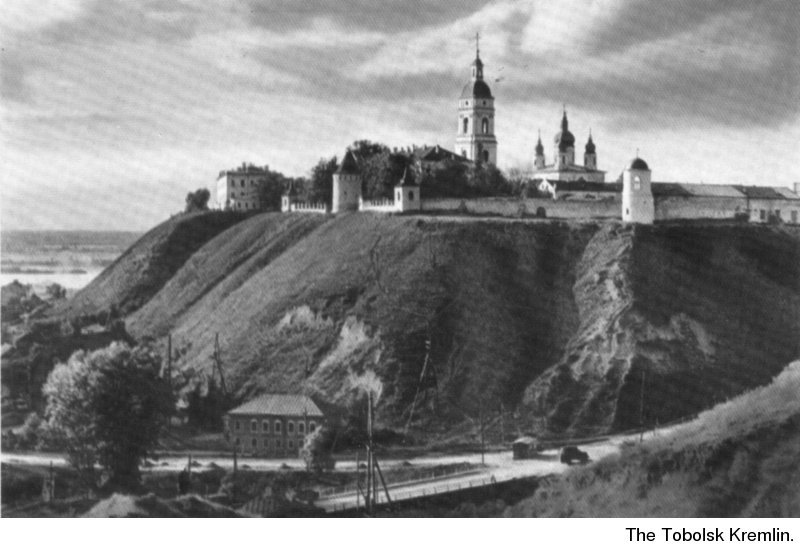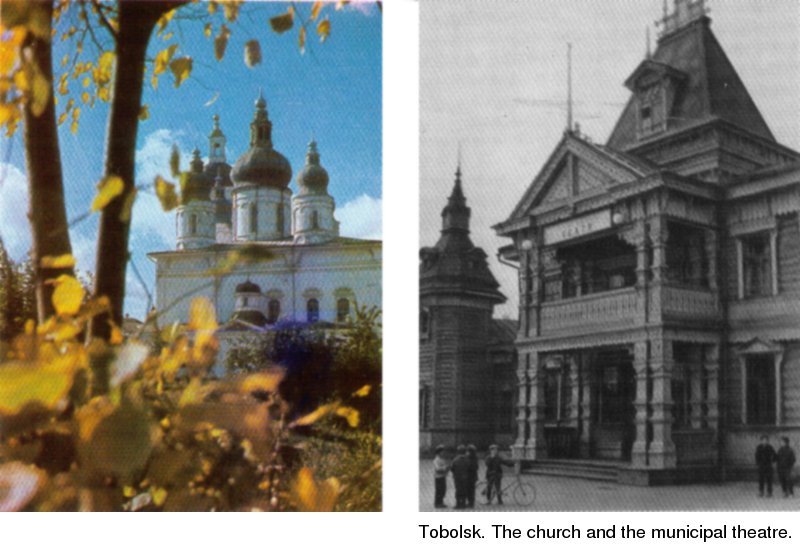I liked the town from the very start, even before I reached it.
I first caught sight of Tobolsk from the deck of a river boat. There emerging from the clouds in the distance was a fairy-tale city from a storybook. I was enchanted by the foamy-white buildings on the high dark cape, the fortress wall and the churches and houses that were all built on a rise and seemed to be floating majestically towards me.
Then I strolled through the town along wooden runner-like sidewalks with grass coming up between the planks. The children I met on the street all greeted me, a stranger in these parts, politely. Young people were dancing on a small paved square near the pier. Asphalt has not yet engulfed Tobolsk. The dancers' shoes scraped on the town's first asphalt, to the strumming of a guitar. Their joy was akin 'to that experienced by a person coming from a world encased in asphalt and taking his first steps on the springy wooden sidewalk.

The wooden residential part of Tobolsk is located at the foot of the knoll. At the top, which is reached by a wooden staircase, is a white island of antiquity. When seen by moonlight it is still more magnificent than in the daytime.
There was a time when Tobolsk was the largest city in all of Siberia. It was the unofficial capital of the lands that began at the Urals and stretched beyond the distant town of Irkutsk. It was the only other city in Russia which played host to foreign ambassadors on a par with Moscow. But Tobolsk was fated to become a quiet provincial town, because it was too far away from the main communication lines. It is an amazing town. One might think it had been stored away in a box and then opened with the words: "Look! Here's the 18th century!"
The young people of Tobolsk do not appreciate this. They say that as soon as oil is discovered in the vicinity everything will change. The old folks, however, are quite content with the peace and quiet, while the visitor discovers a wondrous new world.
Tobolsk is nearly four hundred years old. In 1587 Yermak's troops hastily dismantled their river boats and built the fortress of Tobolsk from the lumber in order to consolidate their victory over Kuchum-khan. The battle, familiar to us from Surikov's painting, took place nearby, on one of the slopes rising from the Irtysh River. Yermak died here. A monument to him in the form of a granite pyramid stands on the knoll beside the fortress.
For many years Tobolsk was a town of wooden structures, which meant it was razed by fire time and time again. These constant fires finally forced the viceregent to ask the tsar for permission to put up buildings of stone. In a short time a stone fortress (kremlin), church, bell-tower and administrative buildings rose on the top of the knoll. At the time, these were the first stone buildings in Siberia. One can easily imagine the impression they made then on a person emerging from the wilderness if the fortress still amazes us today.
Tobolsk consolidated Russia's claim to the lands charted by the early discoverers and became the center of the vast expanses of Siberia. The Church, the army, the various trades, commercial and government bodies all had their headquarters here. Ambassadors and merchants passed through on their way to the East. Nor could explorers or travellers bypass Tobolsk.

To this day the town has retained many traces of its former glory. Even the smallest street has preserved the work of the carpenters who hewed the logs and built the houses, whose imagination and innate sense of beauty and proportion created the carved shutters, the filigreed lattices and the carved wooden animal heads on the roofs. There is a gingerbread house on one of the streets. This is just what a house in a folk-tale should be like, with a porch, lacy cornices, turrets and an attic window. You feel that at any moment a boyar in a tall sable hat or a young woman in a silk sarafan will appear. The building now houses the municipal theater, one of the first in Russia. The local museum and the archives have also been inherited from the past. Scholars from Leningrad, Kiev and Moscow do research here.
The chemist Mendeleyev was born in Tobolsk, as were the artist Perov and the poet Yershov (the author of the immortal Hunchbacked Horse). It is interesting to note that Mendeleyev's father was Yershov's teacher at school, while Yershov was Mendeleyev's teacher. The composer Alyabyev lived here. Many of tsarist Russia's finest sons and daughters lived in exile here. They say the first Siberian exile was a church bell that tolled in the city of Uglich on the day Ivan IV's infant son was murdered. According to the Chronicles, Boris Godunov ordered the bell to be publicly whipped and then exiled to Tobolsk.
Radishchev, Chernyshevsky, Dostoyevsky, Korolenko and many of the Decembrists were among those whom the tsars found objectionable and sentenced to exile. I read their names on the black tombstones in the local cemetery. As if to get even for the deeds of the past, history brought Nicholas II, the last of the Russian tsars, and his family to Tobolsk in 1917.
One finds Kuchum-khan's tombstone among the cannon balls, spears, shields and arrows in the local museum. The inscription on it reads: "Our life lasts but an hour. Let us therefore put it to good use." Every visitor stops to read it.
There were many bearded young men dressed in rough boots in Tobolsk. They were geodesists, geologists and topographers. The lands around Tobolsk, no matter that man has been here for centuries, have not really been charted. Perhaps the oilfields that have already been discovered in the region have their counterparts closer to the town. We should then witness the awakening of a slumbering city. The railroad which once bypassed Tobolsk now branches off here in its winding course through Siberia. The first train pulled into the station in 1967. Large-scale construction has begun, though it is still in the stage of inception.
